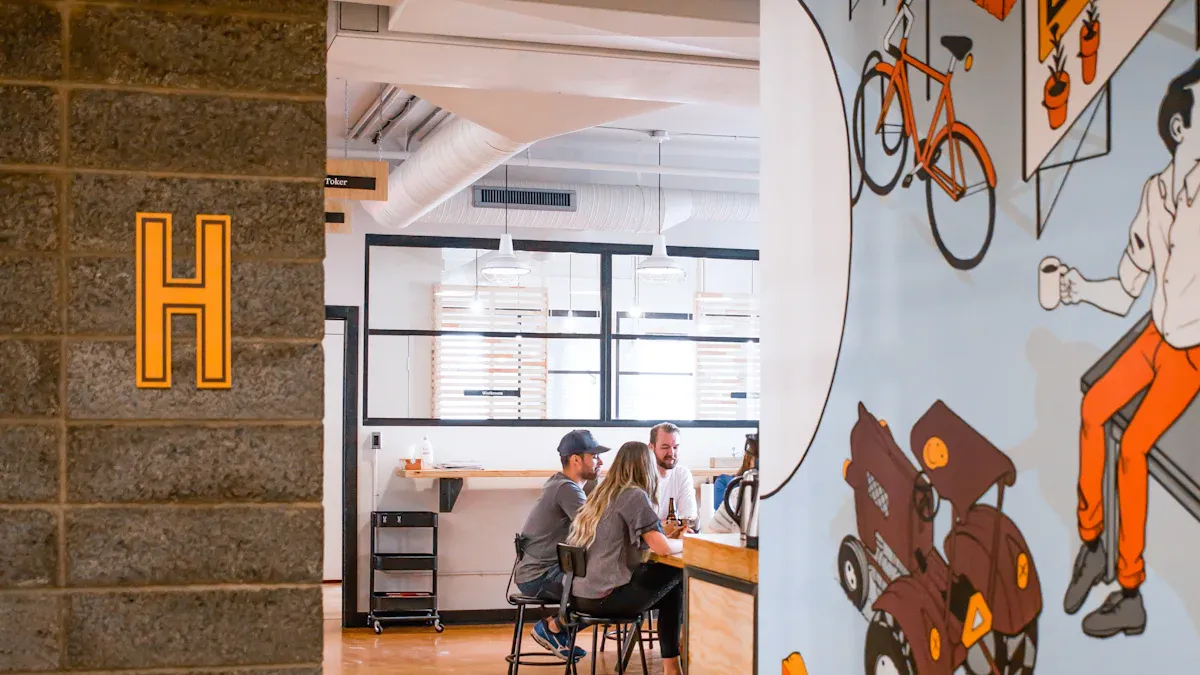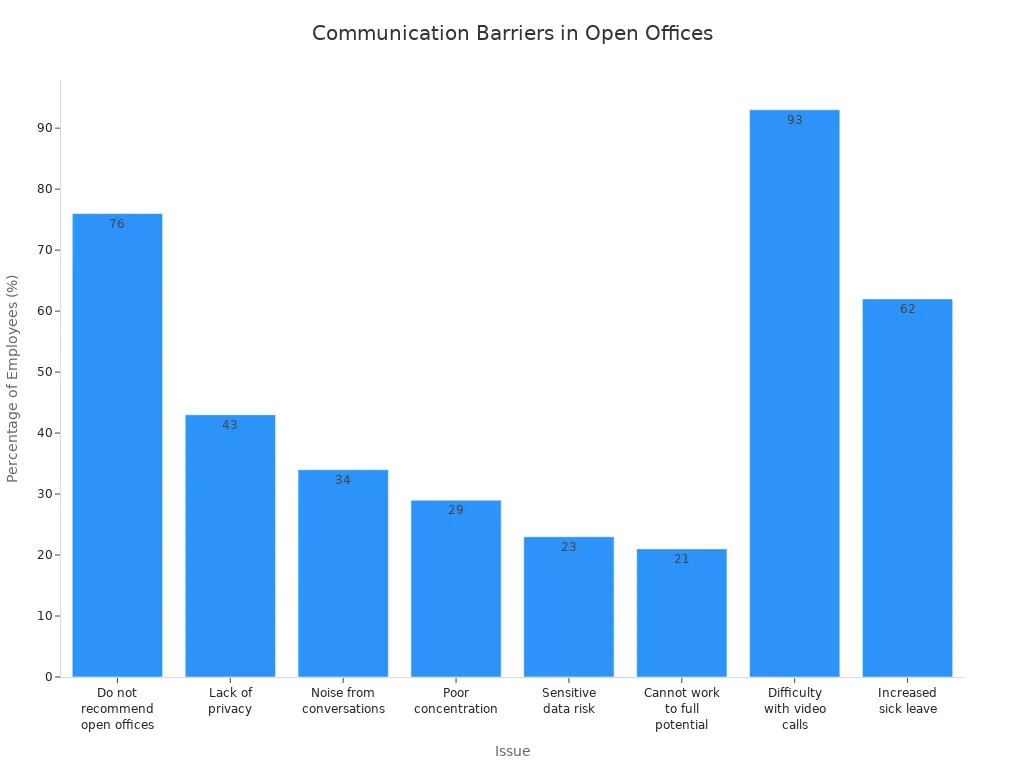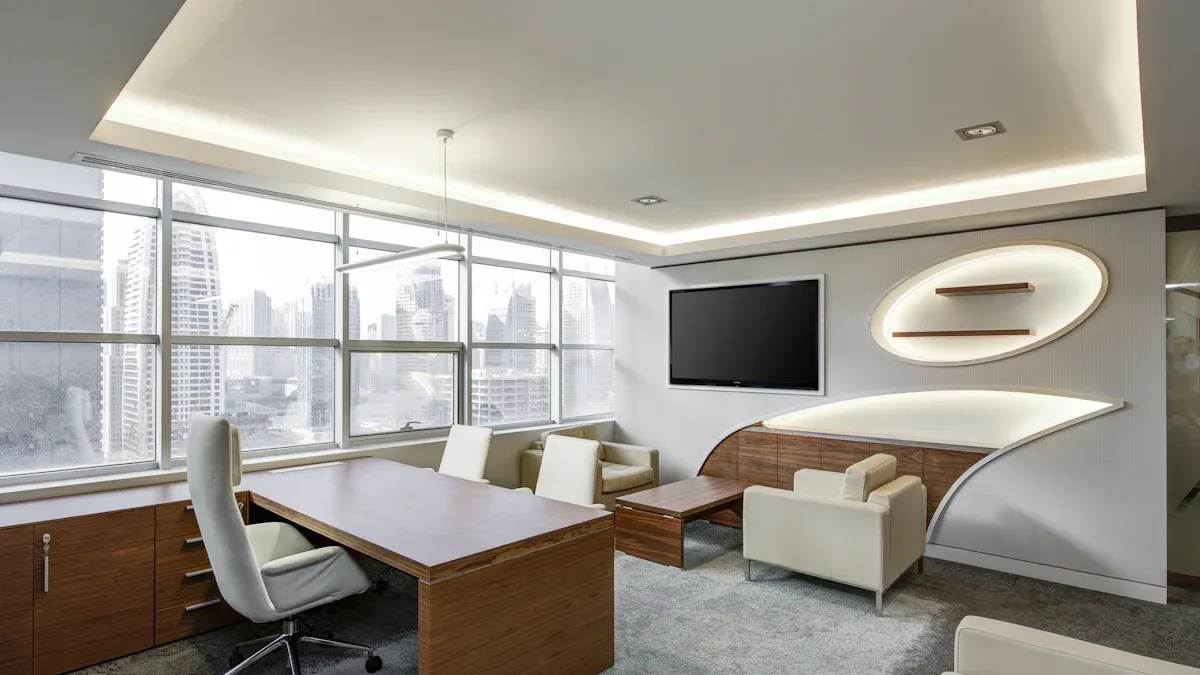
Many modern workplaces now use meeting pods for offices to address noise and privacy challenges in open spaces. Over 41% of global sales target office applications, with more than 120,000 units purchased in 2023. Studies show that 43% of employees struggle with privacy, while 34% report noise issues. An office privacy booth, private meeting pods, or an Office Phone Booth can create quiet zones for focused conversations and video calls.

How Meeting Pods for Offices Affect Team Communication

Ways Meeting Pods Can Help
Meeting pods for offices offer several advantages that can improve team communication and collaboration. These pods create dedicated, soundproof spaces where employees can meet face-to-face without distractions. Teams often find it easier to share ideas and solve problems when they have a quiet place to talk.
- Meeting pods break down physical barriers, making it easier for team members to connect and communicate.
- These spaces encourage personal interaction, which can lead to stronger relationships and better teamwork.
- Pods provide a comfortable, private area for representatives from different departments to gather, discuss project details, and clarify roles.
- Employees can use meeting pods for quiet thinking, allowing them to focus and develop creative solutions without interruptions.
- By offering these benefits, meeting pods for offices help teams feel more unified and connected.
Tip: Teams that use meeting pods often report higher productivity and more effective brainstorming sessions.
Ways Meeting Pods Can Hurt
While meeting pods for offices can support communication, they may also create challenges if not used thoughtfully. Communication barriers sometimes arise when teams become too isolated in their pods. Experts have found that when groups work in separate spaces, they may interact less with other teams. This separation can lead to silos, where departments do not understand each other’s challenges or goals. A study from Microsoft showed that remote work increased silos by reducing cross-team communication and making it harder to share complex information. Meeting pods, when used as segmented spaces, can contribute to this pattern by limiting spontaneous conversations and cross-functional teamwork.
Some common drawbacks include:
- High setup and maintenance costs, which can be a significant investment for some companies.
- Limited capacity, as most pods only fit small groups, making them unsuitable for larger meetings.
- Space requirements, since offices need enough room to install these pods without crowding the workspace.
Teams should consider these factors to avoid creating new barriers while trying to solve existing communication problems.
Key Factors to Consider Before Installing Meeting Pods for Offices

Team Size and Structure
Team size plays a crucial role in the effectiveness of meeting pods for offices. Small teams, usually three to five members, communicate more openly and make decisions faster in pods. Direct and frequent interactions help build trust and reduce miscommunication. As team size grows, communication becomes more complex and formal. Larger groups may struggle to use pods efficiently due to limited space and reduced speaking time for each member. Teams with flexible structures, such as project-based or cross-functional groups, benefit from pods that support both solo and group work.
| Team Size | Communication Style | Effectiveness in Pods |
|---|---|---|
| 3-5 members | Direct, informal, frequent | High |
| 6-12 members | Balanced, some structure | Moderate |
| 12+ members | Formal, complex | Lower |
Work Style and Collaboration Needs
Different work styles influence how teams use meeting pods for offices. Teams that value face-to-face interaction or spontaneous discussions thrive in pods that encourage proximity and collaboration. Pods also support cooperative work styles by providing shared spaces with tools for brainstorming and consensus-building. Adaptable pods allow teams to book spaces that match their communication needs, improving productivity and satisfaction.
Note: Flexible pods help teams with high collaboration needs access digital content, share ideas, and work together in real time.
Pod Placement and Accessibility
Strategic placement of meeting pods within the office boosts spontaneous communication and teamwork. Pods located near workstations enable quick, confidential conversations and support ad hoc meetings. Open and flexible layouts encourage informal interactions, while sound-insulated pods provide privacy for focused work. Features like digital booking systems and occupancy sensors improve accessibility and prevent crowding.
Company Culture and Communication Norms
Company culture shapes how teams use meeting pods. Organizations with open communication norms and supportive leadership see better collaboration and trust. Clear guidelines on when to use pods for meetings or focused work help reduce misunderstandings. Pods align with cultures that value both teamwork and individual focus, offering quiet spaces for deep work and creative thinking.
Pros and Cons of Meeting Pods for Offices: Communication Impact
Communication Benefits
Meeting pods for offices offer several communication advantages. Teams gain access to quiet, semi-private spaces that reduce distractions and support focused conversations. These pods allow employees to hold quick meetings or video calls without booking a large conference room. Pods can be placed near workstations, making it easy for team members to connect when needed.
- Pods encourage face-to-face meetings, which help team members read body language and tone. This improves understanding and builds trust.
- Informal conversations in pods can strengthen team bonds and boost creativity. MIT research shows that informal communication can increase productivity by up to 10%.
- Pods provide managers and executives with a space to engage directly with staff, reinforcing company culture and collaboration.
- Modular design allows for flexible use, supporting both individual focus and small group brainstorming.
Note: Meeting pods for offices often serve as a bridge between open workspaces and traditional meeting rooms, offering privacy without sacrificing accessibility.
Communication Drawbacks
Despite their benefits, meeting pods for offices may present some communication challenges. Pods typically accommodate only a few people, which limits their use for larger group discussions or formal meetings. Traditional meeting rooms remain better suited for sensitive topics or when advanced technology is required.
- Pods may unintentionally create silos if teams use them exclusively, reducing cross-team interaction.
- Limited space can restrict participation, leaving some team members out of important conversations.
- Over-reliance on pods may decrease spontaneous communication in open areas, which can weaken team cohesion over time.
Teams should balance pod use with open communication practices to maintain strong connections across the organization.
Deciding If Meeting Pods for Offices Are Right for Your Team
Decision Framework
Organizations should use a clear framework to decide if meeting pods fit their needs. Leaders can start by identifying the main reasons for considering pods, such as reducing noise or improving privacy. Next, they should evaluate the following criteria:
- Define the intended use—focus work, video calls, or team meetings.
- Assess the number of users and required pod size.
- Review office space design and how pods will fit with current layouts.
- Consider mobility—pods with wheels offer flexibility for changing needs.
- Examine privacy features like soundproofing and lockable doors.
- Match pod design and style to the company’s brand and atmosphere.
- Gather employee feedback to ensure pods meet user preferences.
- Balance cost with quality and essential features.
- Ensure accessibility for all employees, including those with disabilities.
Note: Pods with modular designs can adapt as teams grow or office needs change.
Practical Tips for Implementation
Successful integration of pods requires careful planning. Teams should:
- Place pods at a distance from open work areas to reduce disturbance but keep them accessible.
- Choose pod sizes based on tasks—single-person pods for calls, larger ones for group meetings.
- Use ergonomic furniture and adjustable tables for comfort.
- Integrate technology such as video displays, power outlets, and reliable Wi-Fi.
- Select durable, sustainable materials for long-term use.
- Set clear booking rules and time limits to ensure fair access.
- Communicate policies and provide training for all staff.
- Regularly review pod usage and gather feedback for improvements.
A well-planned approach helps teams maximize the benefits of pods while supporting collaboration and productivity.
Organizations see both benefits and challenges when they add meeting pods. Success depends on team needs, leadership, and clear goals. Experts recommend starting with a pilot, tracking communication quality, and gathering feedback. This approach helps leaders find the right balance for their teams and workplace culture.
FAQ
What is the ideal team size for using a meeting pod?
Small teams of three to five people use meeting pods most effectively. Larger groups may need traditional meeting rooms for better communication.
How do meeting pods support privacy in open offices?
Meeting pods use soundproof materials and enclosed designs. These features help reduce noise and protect confidential conversations.
Can meeting pods improve productivity?
Yes. Meeting pods create quiet spaces for focused work and quick meetings. Teams often report higher productivity and fewer distractions.

